 The jiaozi story
The jiaozi story
For the Northern Chinese, food – as a culture, as a pleasure, as skill and process, as recollection – began with jiaozi. If you follow the string of collective memory to its source, you’ll find these chubby, bite-sized, savory dumplings, with their meat juicy and soft, their wrapping tender and chewy. Anyone who has spent time in the cold, drafty North, or anyone who was born or married into a Northern Chinese family, has a jiaozi story.
Sometimes my grandmother codes her opinion of family members into jiaozi stories. Here’s one: My eldest aunt puts five spice powder into her stuffing. “Oh, it’s awful,” Granny would say, “but she’s always saying hers is the best.” (Too full of herself.) My fat aunt never ate jiaozi until she married a Xuzhou native, a southerner who thinks the northern staple is the best thing since, well, ever. Now, according to Granny, she is the jiaozi-making queen, mincing her own meat by hand for better texture. (Devoted housewife.) My youngest uncle, a Fujian native who married into our family some 25 years ago, has never gotten used to our family’s almost weekly jiaozi meals. Instead, he eats leftovers from the refrigerator and concocts a hot and sour soup from the water used to boil the dumplings. Still, Granny says, he is the only one in our family to have learned her tricky technique for pulling pieces of dough. (Knows how to sacrifice. Not afraid of hard work. Filial pious.)
On Chinese New Year, for those lucky enough to have sheltered their traditional Chinese family gatherings from the divisive forces of modern society, everyone flocks to the home of the family elder, rolls up their sleeves and gets to work. Mincing vegetables. Mixing dough. Rolling wrappers. Shaping dumplings. And eating – making 200 dumplings requires a workforce dedicated to eating. Peanuts or new pennies (for those who have a serious disregard for infectious diseases) are wrapped in one or two dumplings, bringing luck to those who chance upon them. I personally swallowed a few fen during the 1991 New Year’s celebrations.
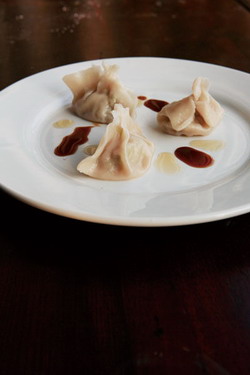 Even the most pampered little emperor will have rolled more than a few wrappers in his or her lifetime, and most will have been doing it since they were in kindergarten. Making jiaozi is not about cooking. It’s about the dynamic act of being Chinese. There is nothing about jiaozi that can be translated into a restaurant experience, which, I suppose, is the reason that restaurant jiaozi is a different species than the homemade variety.
Even the most pampered little emperor will have rolled more than a few wrappers in his or her lifetime, and most will have been doing it since they were in kindergarten. Making jiaozi is not about cooking. It’s about the dynamic act of being Chinese. There is nothing about jiaozi that can be translated into a restaurant experience, which, I suppose, is the reason that restaurant jiaozi is a different species than the homemade variety.As with every cultural archetype, there are as many personal recipes as there are dumpling makers. The basic meat stuffing is of minced pork, with the traditional additions of chives, fennel leaves or napa cabbage. Making the dough is tricky. It depends on such insignificant facts as whether you have a humidifier and how far away from it the dough sits. I say use store- bought dumpling wrappers. For the advanced home cook, I’ve included a recipe for basic stuffing. For the less confident, I highly recommend spending an afternoon wrapping jiaozi with a competent jiaozi-making ayi.
Jiaozi
Makes 80-100 jiaozi. Serves 4.
½ kg minced pork
2 teaspoon minced ginger
3 teaspoon minced green onion
1 tablespoon Chinese cooking sherry
(liàojǐu 料酒)
3 tablespoon light soy sauce (生抽)
2 teaspoon salt, plus more for sprinkling on cabbage.
3 tablespoons pork or chicken stock, or water
10-12 big napa cabbage leaves
80-100 jiaozi wrappers
Combine pork, ginger, green onion, liaojiu, soy sauce, salt, stock or water in a large bowl.
Using chopsticks, stir the mixture well in one direction. Set aside to marinate for 20 to 30 minutes. Meanwhile, chop cabbage leaves by hand or pulse in a food processor with a pinch or two of salt until minced, but not too finely. Using your hands or a cheesecloth, squeeze water from cabbage leaves until the leaves are dry. Combine with pork. Boil a little ball of the stuffing and taste for salt. Adjust seasoning accordingly. Wrap the jiaozi (see below).
When the jiaozi are wrapped, boil a large pot of water seasoned with a pinch of salt. When the water comes to a rolling boil, stir water with a wooden spoon and carefully set the jiaozi into the water. Stir carefully until all jiaozi are in the water. Wait for the water to reach a rolling boil again. When the jiaozi float on the surface of the water, they’re cooked. Drain. Serve with a dipping sauce of vinegar, light soy sauce, garlic, sesame oil and hot sauce.
How to fold jiaozi

Place filling in the center of the wrapper.
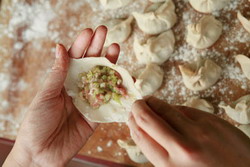
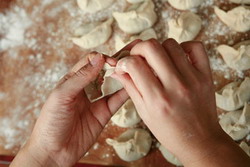
Tug the opposite ends of the wrapper, bring together and seal with a pinch. Tug the left and right corners and fold toward the middle.
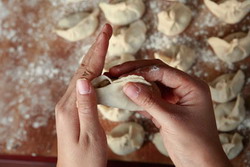


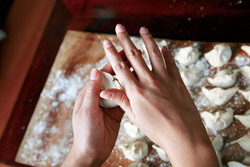
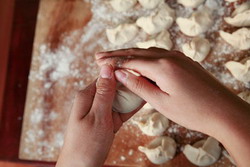
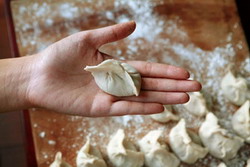
Using your palms, mold dumpling into a crescent shape.



